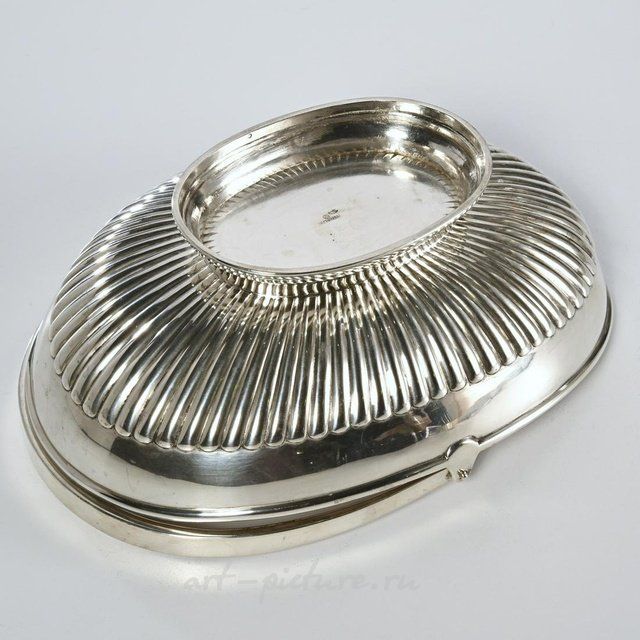Фабрика братьев Грачевых («Бр. Грачевы»), 1866-1918 годы, несомненно, считается одним из самых известных, выдающихся и самобытных предприятий дореволюционного Санкт-Петербурга по производству изделий из серебра, золота и гальваники. Родоначальником всемирно известного семейного бизнеса стал Грачев Гавриил Петрович. Будучи мастером серебряного дела и проработав довольно продолжительное время в фирме «Гассе» в 1866 году Гавриил Петрович открывает собственный бизнес по производству серебряных изделий. И уже через год, в 1867 году, уникальное серебро с именным клеймом «ГРАЧЕВЪ» и работавших на фирму мастеров, ценители покупают в собственной лавке фирмы под Думою №1 и №2.Гавриил Петрович подготовил достойную смену, и его сыновья - Михаил, Алексей, Григорий, Семен, Николай, Гавриил, Петр, Иван - продолжили дело отца с огромным успехом. Так, в 1892 году фирма получила заслуженное звание придворного поставщика и исключительное доверительное право клеймить свои изделия законным изображением двуглавого орла, а в 1901 году звание поставщика Высочайшего двора было безоговорочно подтверждено.Семейный бизнес развивался семимильными шагами и из небольшой мастерской к 1895 году вырос в фабрику «Братья Грачевы» с численностью персонала 87 человек и стабильным годовым товарооборотом в сто двадцать пять тысяч рублей. В 1900 году Михаил и Семен, следуя экономическим тенденциям предприятий-лидеров того времени, в качестве полных товарищей, с участием вкладчиков, остальных братьев, открывают торговый дом «Братья Грачевы».К этому времени изделия фабрики братьев Грачевых уверенно завоевывают награды всероссийских и всемирных художественно-промышленных выставок, в т.ч. выставок Чикаго и Нижнего Новгорода. На выставке в Копенгагене фирмой получена Золотая медаль на Станиславской ленте. Невозможно недооценить и влияние личных достижений братьев на развитие семейного дела. Так, Семен Гаврилович с отличием окончил Коммерческое училище доктора Видемана (его закончил также и Агафон К. Фаберже). Михаил Гаврилович с 1892 года являлся штатным оценщиком Кабинета Его Императорского Величества.В 1917 году в связи с кардинально изменившейся политической ситуацией ассортимент производимой продукции на фабрике сузился до столового серебра и ручных гранат. 2 марта 1918 года, как и многие предприятия царской России, фабрика братьев Грачевых со всеми входящими в нее структурными подразделениями была закрыта.Выпускаемая продукция: уникальные по красоте предметы культа, бытовые изделия, туалетные принадлежности, кабинетная скульптура, посуда и другие изделия фабрики братьев Грачевых были приветливо узнаваемы не только при дворе, но и широкой публикой.Изделиям Грачевых свойственны общие тенденции серебряного и золотого дела ХIХ века в виде украшения предметов живописными эмалевыми дробницами (портреты, пейзажи, античные сцены) или покрытия тончайшим слоем полупрозрачной эмали вырезанного на золотой или серебряной основе сложно сплетенного орнамента или изображения.Техника эмали по скани представлена изумительным антикварным набором кофейных ложек, изготовленных из серебра 88-й пробы в мастерской «НА» для фирмы Грачевых в последней четверти XIX века. Набор включает 12 кофейных ложечек, сформированных из двух комплектов, одинаковых по форме и различных по узору.Благодаря механизации труда на фабриках к концу века прием эмали по скани получил широкое развитие: гильошированные узоры резного орнамента мастера Грачевых покрывают эмалью ярких выразительных, и, в то же время, прозрачных, цветов. Характерной особенностью, придающей изделиям фирмы Грачевых еще большую историческую уникальность, являются выполненные мастерами на высочайшем профессиональном уровне плоские узоры паутинчатой скани с эмалью уже не таких выразительных, более блеклых тонов, преимущественно желтого и зеленого оттенков.Особый статус фирме Грачевых, а также определяющим одно из ее стилистических направлений, является тот факт, что братья Грачевы в Петербурге были исполнителями заказов церкви. Поэтому композиция художественного замысла мастеров зачастую напрямую зависела от исторически сложившейся, диктуемой канонами церкви, формы самого предмета и от четкой гармонии, пропорциональности, в расположении на нем различных рисунков.Согласно оценкам экспертов (классификация команды заслуженного деятеля декоративно-прикладного искусства, эксперта Министерства культуры Российской Федерации Александра Николаевича Иванова) фабрика братьев Грачевых относится к первой высшей категории ювелиров и фирм золотого и серебряного дела дореволюционной России. Это означает, что произведения фабрики, как по рабочим характеристикам, так и по стоимости, равнозначны именитым произведениям Фаберже.Исторические особенности организации золотого и серебряного дела в России ХIХ века нашли отражение и в клеймении серебряных изделий того времени.Для всех городов в ХVIII и ХIХ в.в. клеймение пробирерами клейма включало три типа клейм. Первое клеймо изображало герб города и год производства (или без года), заключенные в прямоугольник. Второе клеймо содержало инициалы имени и фамилии («именник») пробирного мастера и год клеймения (или без года), заключенные в прямоугольник. Третье клеймо обозначало пробу в виде двух цифр, заключенных в прямоугольник.Отдельным мастерам и владельцам небольших мастерских было чрезвычайно трудно конкурировать со стремительно развивающимся крупным производством. Многие мастера предпочитали работать на более крупные фирмы.До предъявления изделий государственному пробиреру мастера и фабрика обязаны были ставить свои клейма-именники.Так, известный петербургский мастер-ювелир, золотых дел мастер, купец 2-й гильдии Иоганн Фердинандович Ольсониус, выполняя изделия для фабрики Грачева, ставил на изделии и клеймо фабрики (БР.ГРАЧЕВЫ, БР.ГР., ГРАЧЕВЪ) и именник мастера (JO).Фабрика братьев Грачевых, будучи придворным поставщиком, вместе с именником с 1892 года имела право клеймить свои изделия законным изображением государственного герба.С начала 1899 года Новым пробирным уставом 1896 года для всех мастеров и предприятий России было установлено дополнительное единое клеймо, изображающее женскую голову в кокошнике, взгляд которой направлен влево.




